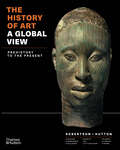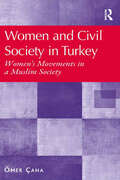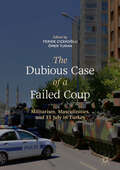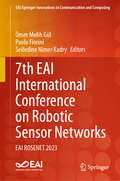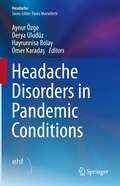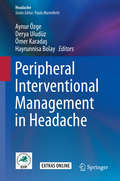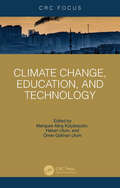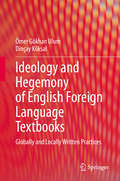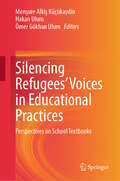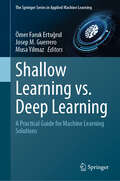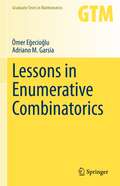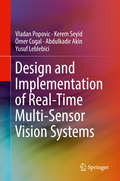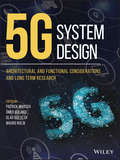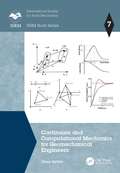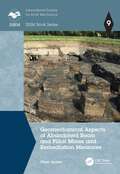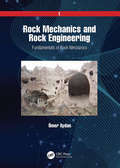- Table View
- List View
The History of Art: A Global View: Prehistory to the Present (Vol. Combined Volume)
by Rex Koontz Jean Robertson Ömür Harmansah Stacey Sloboda Deborah Hutton Cynthia Colburn Eric Kjellgren De-nin Lee Henry Luttikhuizen Allison Lee Palmer Monica Blackmun VisonàA more global, flexible way to teach art history The History of Art: A Global View is the first major art history survey textbook -- written by a team of expert authors -- with a global narrative in mind. A chronological organization and “Seeing Connections” features help readers make cross-cultural comparisons, while brief, modular chapters (with on-page definitions) offer instructors unparalleled flexibility. You can assign more than one chapter per week for a fully global course, or skip and reorder chapters, for a more focused syllabus.
Cities and the Shaping of Memory in the Ancient Near East
by Ömür HarmanahThis book investigates the founding and building of cities in the ancient Near East. The creation of new cities was imagined as an ideological project or a divine intervention in the political narratives and mythologies of Near Eastern cultures, often masking the complex processes behind the social production of urban space. During the Early Iron Age (ca. 1200-850 BCE), Assyrian and Syro-Hittite rulers developed a highly performative official discourse that revolved around constructing cities, cultivating landscapes, building watercourses, erecting monuments, and initiating public festivals. This volume combs through archaeological, epigraphic, visual, architectural, and environmental evidence to tell the story of a region from the perspective of its spatial practices, landscape history, and architectural technologies. It argues that the cultural processes of the making of urban spaces shape collective memory and identity as well as sites of political performance and state spectacle.
Women and Civil Society in Turkey: Women's Movements in a Muslim Society
by Ömer ÇahaFocusing on three important interrelated issues, Women and Civil Society in Turkey challenges the classical definition, developed in the West, of civil society as an equivalent of the public sphere in which women are excluded. First it shows how feminist movements have developed a new definition of civil society to include women. Second it draws attention to the role of women in the modernization of Turkey with special reference to the debate on the possibility of an indigenous feminist movement. Finally, it underlines the contribution of feminist, Islamic and Kurdish women’s movements in the transition from an ideologically constructed, uniform public sphere to a multi-public domain. Giving attention to the influence of diverse women’s movements over Turkish political values this book sheds light into the issue of how a feminine civil society has been constructed as part of a plural public space in Turkey. Ömer Çaha argues that this new public realm is the product of values and institutions which have been developed by diverse women’s groups who have succeeded in eliminating the traditional barricades between public and domestic spheres and in steering women into public life without sacrificing their own values.
The Dubious Case of a Failed Coup: Militarism, Masculinities, and 15 July in Turkey
by Feride Çiçekoğlu Ömer TuranThis volume is an attempt to contextualise the coup attempt of 15 July 2016 in Turkey, within the framework of militarism and masculinities. The immediate aftermath of the 15 July in Turkey witnessed confusion, contestation and negotiation among different narratives, until a hegemonic version was superimposed on the collective memory as part of official history building. This project is an attempt to bring a fresh and critical perspective by compiling together analyses from various disciplines of political science, media and film studies, literature, sociology and cultural studies. Several chapters of this volume delineate the paradox of “victorious militarism,” meaning that despite the failure of the coup, its aftermath has been shaped by a new wave of state-sponsored gendered militarism, with the establishment of a regime of “state of emergency.”
The Nation or the Ummah: Islamism and Turkish Foreign Policy
by Birol Başkan Ömer TaşpınarTurkey's enthusiastic embrace of the Arab Spring set in motion a dynamic that fundamentally altered its relations with the United States, Russia, Qatar, Egypt, Saudi Arabia, the United Arab Emirates, and Iran, and transformed Turkey from a soft power to a hard power in the tangled geopolitics of the Middle East. Birol Başkan and Ömer Taşpınar argue that the ruling Justice and Development Party's (AKP) Islamist background played a significant role in the country's decision to embrace the uprisings and the subsequent foreign policy direction the country has pursued. They demonstrate that religious ideology is endogenous to—shaping and in turn being shaped by—Turkey's various engagements in the Middle East. The Nation or the Ummah emphasizes that while Islamist religious ideology does not provide specific policy prescriptions, it does shape the way the ruling elite sees and interprets the context and the structural boundaries they operate within.
7th EAI International Conference on Robotic Sensor Networks: EAI ROSENET 2023 (EAI/Springer Innovations in Communication and Computing)
by Paolo Fiorini Ömer Melih Gül Seifedine Nimer KadryThis book presents the proceedings of the 7th EAI International Conference on Robotics and Networks 2023 (EAI ROSENET 2023). The conference explores the integration of networks, communications, and robotic technologies, which has become a topic of increasing interest for both researchers and developers from academic fields and industries worldwide. The authors posit that big networks will be the main approach to the next generation of robotic research, with the explosive number of communications and networks models and increasing computational power of computers significantly extending the number of potential applications for robotic technologies while also bringing new challenges to the communications and networking community. The conference provided a platform for researchers to share up-to-date scientific achievements in this field. The conference takes place at Bahcesehir University, Istanbul, Türkiye on 15-16 December 2023.
Headache Disorders in Pandemic Conditions (Headache)
by Aynur Özge Derya Uludüz Ömer Karadaş Hayrunnisa BolayThis book provides a physician’s pathfinder for COVID specific headache disorders as well as general headache practice in a pandemic era. Practical solutions to headache management at every level are highlighted, along with the changing nature of previous headache disorders under lockdown conditions. Headache Disorders in Pandemic Conditions examines the specific nature of headache symptoms during COVID-19 infection, the secondary causes of COVID-specific headache disorders and practical issues of previous known headache disorders during a pandemic. The book also explores the effect of lockdown on headache management and changes in headache education, practice, risks and guidelines. Neurologists, headache specialists, general practitioners, medical students and residents will find this book to be a practical and clear guide to Covid-19 specific headache disorders in clinical practice.
Peripheral Interventional Management in Headache (Headache)
by Aynur Özge Derya Uludüz Ömer Karadaş Hayrunnisa BolayThis book discusses interventional treatment options on intractable (drug resistant) headache patients and extended headache attacks and extensively reviews the reasons behind treatment failure in intractable headaches, offering potential solutions based on clinical black holes of headache outpatient practice. The most appropriate interventions for certain types of headache such as chronic migraine and medication-overuse headaches, are discussed among others.The book provides practical advice on properly administering the interventional treatments either as a bridge treatments or prophylaxis options. The expected complications of the treatments, and strategies to minimize them are also discussed. Approaches in special patient populations such as pediatric or pregnancy cases and other non-standard cases are also extensively discussed.
Climate Change, Education, and Technology
by Ömer Gökhan Ulum Hakan Ulum Menşure Alkış KüçükaydınThe climate change crisis is the greatest challenge humanity has ever confronted. As human activities are the most significant cause for this crisis, the solution must come from within humanity. While global movements—NGOs, universities, municipal governments, etc.—are doing their part to combat the crisis, the role of education and technology cannot be emphasized enough. Education is necessary to enhance awareness, especially among the youth, generate solutions, and implement them. Technology contributes to this process by creating climate change-fighting solutions, accumulating and analysing data, and providing energy efficiency. Technology also enables the monitoring of the climate, the mitigation of its effects, and the enhancement of the environment. Therefore, climate change, education, and the use of technology should be addressed as a unit. In this volume, the authors integrate climate change, education, and technological applications.This book is comprehensive and offers readers a variety of perspectives, encouraging the generation of novel and inventive ideas. The collaboration of authors from various disciplines to address the issue brings about novel and intriguing perspectives.
Ideology and Hegemony of English Foreign Language Textbooks: Globally and Locally Written Practices
by Ömer Gökhan Ulum Dinçay KöksalThis volume investigates ideological and hegemonic practices in globally and locally written English as a Foreign Language (EFL) textbooks, and explores whether these textbooks reflect the values, beliefs and norms of the native-speaker society by examining their ideological components and the hegemonic practices by means of which the source society or state seeks to influence learners of the language. It also attempts to clarify EFL teachers’ and students’ views on the underlying ideology and hegemonic practices in globally and locally written EFL textbooks. Studies on the relationship between ideology, hegemony and textbooks in applied linguistics have become more prevalent in recent decades, as the emergence of critical theory, critical pedagogy, and critical thinking skills from the 1920s onwards has led scholars to adopt a more critical perspective towards EFL textbooks, especially with regard to elements of ideology and hegemony. These two terms encompass a plethora of components, ranging from nationalism to religion. At the same time, the importance of metanarratives originating from the tenets of modernism has declined from the 1960s onwards, the assumption being that the world has entered a new age called postmodernism and post-structuralism that emphasizes the role of individuals and rejects efforts to reinforce post-colonialism, the effects of which can be seen in EFL textbooks. Accordingly, taking the elements of ideology and hegemony into account remains a vital aspect in the analysis of EFL textbooks.
Silencing Refugees’ Voices in Educational Practices: Perspectives on School Textbooks
by Ömer Gökhan Ulum Menşure Alkiş Küçükaydin Hakan UlumThis book foregrounds silenced voices by correlating refugee experiences with educational practices, while questioning how we address the educational rights of individuals affected by conflicts and wars. Accordingly, the book presents a novel perspective within the field of education. Within the context of the most prevalent educational instruments, textbooks, this work endeavors to highlight the muted perspectives of immigrants in education and make significant advances towards resolving this problem. Through extensive research and analysis of the relevant literature, the authors shed light on the challenges refugee students face in their educational trajectories and offer innovative suggestions for adopting more equitable and inclusive approaches within our educational systems. The book not only addresses an educational dilemma, but also emphasizes humanity's shared responsibility. Supporting the educational rights of refugees promotes not only their personal growth, but also more tolerant, compassionate, and sustainable societies. At the same time, this work promotes a critical comprehension of refugee experiences in education by presenting both problems and solutions to the readership. In this way, it demonstrates how a more equitable and egalitarian approach to education can be adopted and it ultimately encourages readers to adopt a broader perspective on the world, embracing humanitarian values and social responsibility.
Undividing Digital Divide: Digital Literacy (SpringerBriefs in Education)
by Ömer Gökhan Ulum Dinçay Köksal Gülten GençThis book problematizes digital divide with critical lens by focusing on education in general and specifically second language education with an emphasis on the context of Turkey based on sound methodologies and robust theories of modernity, postmodernity, post-structuralism and post-method framework. In line with this conceptualization, critical thinking skills, social dialogue, collaboration, accessibility and digital literacy have been widely discussed empirically and prioritized in this book. In addition, social injustice, digital inequality, gender gap, economic disparity, demographic differences and knowledge divide have also been addressed. EFL teachers and pre-service teachers as cultural workers have been incorporated into the studies to critically reflect upon digital divide in Turkey. The views of teachers and learners at a socio-economic disadvantage emanating from socio-political issues have been addressed and foregrounded. The digital divide and inequalities that COVID-19 pandemic has produced have also been emphasized. The context of Turkey where digital divide has been prevalent during COVID-19 pandemic is believed to inspire researchers specializing in digitalization and digital education. The strategies, problems, effects and solutions have been presented. This book presents a reliable source to students, teachers and academics in education and second language education as well as social scientists and policy-makers across the globe.
Conducting Technology Acceptance Research in Education: Theory, Models, Implementation, and Analysis (Springer Texts in Education)
by Ömer Faruk UrsavaşThis book provides an in-depth discussion of the emergence of technology acceptance theories and models, how we can use these theories and models in education, and data collection and analysis processes of technology acceptance research in education. The book discusses how we can make meaning of technology and apply it to educational settings while we investigate the processes via which people adopt technology in education. The book will appeal to students enrolled in upper undergraduate and graduate courses that cover technology acceptance and use in education, researchers who would like to conduct technology acceptance research in education and need a comprehensive resource, and practitioners such as teachers and administrators who would like to promote technology use at schools.
Shallow Learning vs. Deep Learning: A Practical Guide for Machine Learning Solutions (The Springer Series in Applied Machine Learning)
by Josep M. Guerrero Ömer Faruk Ertuğrul Musa YilmazThis book explores the ongoing debate between shallow and deep learning in the field of machine learning. It provides a comprehensive survey of machine learning methods, from shallow learning to deep learning, and examines their applications across various domains. Shallow Learning vs Deep Learning: A Practical Guide for Machine Learning Solutions emphasizes that the choice of a machine learning approach should be informed by the specific characteristics of the dataset, the operational environment, and the unique requirements of each application, rather than being influenced by prevailing trends. In each chapter, the book delves into different application areas, such as engineering, real-world scenarios, social applications, image processing, biomedical applications, anomaly detection, natural language processing, speech recognition, recommendation systems, autonomous systems, and smart grid applications. By comparing and contrasting the effectiveness of shallow and deep learning in these areas, the book provides a framework for thoughtful selection and application of machine learning strategies. This guide is designed for researchers, practitioners, and students who seek to deepen their understanding of when and how to apply different machine learning techniques effectively. Through comparative studies and detailed analyses, readers will gain valuable insights to make informed decisions in their respective fields.
Lectures in Algebraic Combinatorics: Young's Construction, Seminormal Representations, SL(2) Representations, Heaps, Basics on Finite Fields (Lecture Notes in Mathematics #2277)
by Adriano M. Garsia Ömer EğecioğluCapturing Adriano Garsia's unique perspective on essential topics in algebraic combinatorics, this book consists of selected, classic notes on a number of topics based on lectures held at the University of California, San Diego over the past few decades. The topics presented share a common theme of describing interesting interplays between algebraic topics such as representation theory and elegant structures which are sometimes thought of as being outside the purview of classical combinatorics. The lectures reflect Garsia’s inimitable narrative style and his exceptional expository ability. The preface presents the historical viewpoint as well as Garsia's personal insights into the subject matter. The lectures then start with a clear treatment of Alfred Young's construction of the irreducible representations of the symmetric group, seminormal representations and Morphy elements. This is followed by an elegant application of SL(2) representations to algebraic combinatorics. The last two lectures are on heaps, continued fractions and orthogonal polynomials with applications, and finally there is an exposition on the theory of finite fields. The book is aimed at graduate students and researchers in the field.
Lessons in Enumerative Combinatorics (Graduate Texts in Mathematics #290)
by Adriano M. Garsia Ömer EğecioğluThis textbook introduces enumerative combinatorics through the framework of formal languages and bijections. By starting with elementary operations on words and languages, the authors paint an insightful, unified picture for readers entering the field. Numerous concrete examples and illustrative metaphors motivate the theory throughout, while the overall approach illuminates the important connections between discrete mathematics and theoretical computer science. Beginning with the basics of formal languages, the first chapter quickly establishes a common setting for modeling and counting classical combinatorial objects and constructing bijective proofs. From here, topics are modular and offer substantial flexibility when designing a course. Chapters on generating functions and partitions build further fundamental tools for enumeration and include applications such as a combinatorial proof of the Lagrange inversion formula. Connections to linear algebra emerge in chapters studying Cayley trees, determinantal formulas, and the combinatorics that lie behind the classical Cayley–Hamilton theorem. The remaining chapters range across the Inclusion-Exclusion Principle, graph theory and coloring, exponential structures, matching and distinct representatives, with each topic opening many doors to further study. Generous exercise sets complement all chapters, and miscellaneous sections explore additional applications. Lessons in Enumerative Combinatorics captures the authors' distinctive style and flair for introducing newcomers to combinatorics. The conversational yet rigorous presentation suits students in mathematics and computer science at the graduate, or advanced undergraduate level. Knowledge of single-variable calculus and the basics of discrete mathematics is assumed; familiarity with linear algebra will enhance the study of certain chapters.
Entwicklung eines Automated Valet Parking Systems im Rahmen des Forschungsprojekts ANTON (BestMasters)
by Ömer DönmezAutomated Valet Parking Systeme (AVPS) entbinden den Fahrer vom Parkprozess. Wegen der einfachen Verkehrsregeln und der geringen Geschwindigkeiten auf Parkplätzen sind AVPS prädestiniert als erstes kommerzielles Assistenzsystem des SAE Level 4. Viele der heute bekannten Systeme setzen auf eine Kombination aus Sensoren aktueller Fahrzeuge mit Sensoren der Infrastruktur. Zu diesem Zweck werden Parkanlagen mit umfassender Sensorik ausgestattet, um die Fahrzeuge bei der Umgebungserfassung und Routenplanung zu unterstützen. Das Ziel dieser Arbeit ist der Entwurf eines AVPS, welches einen minimalen Aufwand für die Erweiterung der Infrastruktur erfordert und aktuelle Fahrzeugtechnik verwendet. Hierfür werden zunächst Grundlagen beschrieben, um die Funktionsweise und den Nutzen von AVPS zu beleuchten. Anschließend wird das System mithilfe passender Diagramme entworfen und eingegrenzt. Die abschließende Darstellung von Simulationsergebnissen zeigt, ob die geforderten Funktionalitäten umgesetzt werden konnten. Der Arbeit stellt dar, dass die Parkanlage nur um eine Kommunikationsmöglichkeit erweitert werden muss, um ein sicheres und rentables AVPS zu entwickeln.
Design and Implementation of Real-Time Multi-Sensor Vision Systems
by Yusuf Leblebici Vladan Popovic Kerem Seyid Ömer Cogal Abdulkadir AkinThis book discusses the design of multi-camera systems and their application to fields such as the virtual reality, gaming, film industry, medicine, automotive industry, drones, etc. The authors cover the basics of image formation, algorithms for stitching a panoramic image from multiple cameras, and multiple real-time hardware system architectures, in order to have panoramic videos. Several specific applications of multi-camera systems are presented, such as depth estimation, high dynamic range imaging, and medical imaging.
An Archaeology of the Turkish War of Independence: Landscape and Time (Material Culture and Modern Conflict)
by Ömer Can AksoyThis book is about the conflict which resolved the Greek–Turkish War of 1919–1922: the Great Offensive. On 26 August 1922, the army of the GNA executed the Great Offensive against the Greek defence line extending from the Bay of Gemlik to the Meander River. The Turkish Forces split the Greek Army into two large groups, annihilated one of the groups in the field at the Battle of Dumlupınar on 30 August and pursued the remaining forces of the Greek Army towards the Aegean and Marmara coasts until 18 September. Within these 24 days, the face of Western Anatolia changed unalterably: numerous towns, villages and cities of Western Anatolia were reduced to ashes. This conflict was a turning point in the histories of Turkey and Greece, as it played a significant role in shaping the present-day demographic and geopolitical landscapes of both nations. It resulted in a population exchange in 1923 that dramatically altered the lives of Muslims in Greece and Greek Orthodox people in Turkey and paved the way to the foundation of the Republic of Turkey. Despite the outcome of this war and the existence of a rich literature on its military and political history, the landscapes, memoryscapes and material culture have not been systematically investigated. This book bridges that gap via an archaeological, historical and oral-historical study of the Great Offensive and its aftermath. With its wide chronological perspective, this book is not a pure analysis of a historical war, it is instead a journey into the foundation myth of the Turkish Republic and the ideological foundations of the Turkish state.
5G System Design: Architectural and Functional Considerations and Long Term Research
by Patrick Marsch Ömer Bulakci Olav Queseth Mauro BoldiThis book provides a comprehensive overview of the latest research and standardization progress towards the 5th generation (5G) of mobile communications technology and beyond. It covers a wide range of topics from 5G use cases and their requirements, to spectrum, 5G end-to-end (E2E) system architecture including core network (CN), transport network (TN) and radio access network (RAN) architecture, network slicing, security and network management. It further dives into the detailed functional design and the evaluation of different 5G concepts, and provides details on planned trials and pre-commercial deployments across the globe. While the book naturally captures the latest agreements in 3rd Generation Partnership Project (3GPP) New Radio (NR) Release 15, it goes significantly beyond this by describing the likely developments towards the final 5G system that will ultimately utilize a wide range of spectrum bands, address all envisioned 5G use cases, and meet or exceed the International Mobile Telecommunications (IMT) requirements for the year 2020 and beyond (IMT-2020). 5G System Design: Architectural and Functional Considerations and Long Term Research is based on the knowledge and consensus from 158 leading researchers and standardization experts from 54 companies or institutes around the globe, representing key mobile network operators, network vendors, academic institutions and regional bodies for 5G. Different from earlier books on 5G, it does not focus on single 5G technology components, but describes the full 5G system design from E2E architecture to detailed functional design, including details on 5G performance, implementation and roll-out.
2019 Rock Dynamics Summit: Proceedings of the 2019 Rock Dynamics Summit (RDS 2019), May 7-11, 2019, Okinawa, Japan
by Ömer Aydan Takashi Ito Takafumi Seiki Katsumi Kamemura Naoki IwataRock dynamics has become one of the most important topics in the field of rock mechanics and rock engineering, and involves a wide variety of topics, from earthquake engineering, blasting, impacts, failure of rock engineering structures as well as the occurrence and prediction of earthquakes, induced seismicity, rock bursts to non-destructive testing and explorations. Rock dynamics has wide applications in civil and infrastructural, resources and energy, geological and environmental engineering, geothermal energy, and earthquake hazard management, and has become one of the most topical areas. 2019 Rock Dynamics Summit contains 8 keynote addresses and 128 regular full papers that were presented at the 2019 Rock Dynamics Summit (2019 RDS, Okinawa, Japan, 7-11 May 2019), a specialized conference jointly organized by the Rock Dynamics Committee of the Japanese Society of Civil Engineers (JSCE-RDC), the Japanese Society for Rock Mechanics (JSRM), and which was supported by the International Society for Rock Mechanics and Rock Engineering (ISRM) and the Turkish National Society for Rock Mechanics (TNSRM). The contributions cover a wide range of topics on the dynamic behavior of rock and rock masses and scientific and engineering applications, and include: - Laboratory tests on Dynamic Responses of Rocks and Rock Masses / Fracturing of Rocks and Associated Strong Motions- Estimation Procedures and Numerical Techniques of Strong Motions Associated with the Rupture of Earth’s Crust and Some Strong Motion- Dynamic Response and Stability of Rock Foundations, Underground Excavations in Rock, Rock Slopes Dynamic Responses and Stability of Stone Masonry Historical Structures and Monuments- Induced Seismicity- Dynamic Simulation of Loading and Excavation- Blasting and machinery induced vibrations- Rockburst, Outburst, Impacts- Nondestructive Testing Using Shock Waves- Case Histories of Failure Phenomenon in Rock Engineering 2019 Rock Dynamics Summit contains the state-of-the-art in rock dynamics, and will be invaluable to professionals and academics interested in the latest advances in new techniques for experiments, analytical and numerical modelling as well as monitoring in dynamics of rocks and rock engineering structures.
Continuum and Computational Mechanics for Geomechanical Engineers (ISRM Book Series #1)
by Ömer AydanThe field of rock mechanics and rock engineering utilizes the basic laws of continuum mechanics and the techniques developed in computational mechanics. This book describes the basic concepts behind these fundamental laws and their utilization in practice irrespective of whether rock/rock mass contains discontinuities. This book consists of nine chapters and six appendices. The first four chapters are concerned with continuum mechanics aspects, which include the basic operations, definition of stress and strain tensors, and derivation of four fundamental conservation laws in the simplest yet precise manner. The next two chapters are the preparation for computational mechanics, which require constitutive laws of geomaterials relevant to each conservation law and the procedures for how to determine required parameters of the constitutive laws. Computational mechanics solves the resulting ordinary and partial differential equations. In Chapter 7, the methods of exact (closed-form) solutions are explained and they are applied to ordinary/partial differential equations with solvable boundary and initial conditions. In Chapter 8, the fundamentals of approximate solution methods are explained for one dimension first and then how to extend them to multi-dimensional problems. The readers are expected to learn and clearly understand how they are derived and applied to various problems in geomechanics. The final chapter involves the applications of the approximate methods to the actual problems in practice for geomechanical engineers, which cover the continuum to discontinuum, including the stress state of the earth as well as the ground motions induced by earthquakes. Six appendices are provided to have a clear understanding of continuum mechanics operations and procedures for how to deal with discontinuities/interfaces often encountered in rock mechanics and rock engineering.
Earthquake Science and Engineering
by Ömer AydanEarthquakes form one of the categories of natural disasters that sometimes result in huge loss of human life as well as destruction of (infra)structures, as experienced during recent great earthquakes. This book addresses scientific and engineering aspects of earthquakes, which are generally taught and published separately. This book intends to fill the gap between these two fields associated with earthquakes and help seismologists and earthquake engineers better communicate with and understand each other. This will foster the development of new techniques for dealing with various aspects of earthquakes and earthquake-associated issues, to safeguard the security and welfare of societies worldwide. Because this work covers both scientific and engineering aspects in a unified way, it offers a complete overview of earthquakes, their mechanics, their effects on (infra)structures and secondary associated events. As such, this book is aimed at engineering professionals with an earth sciences background (geology, seismology, geophysics) or those with an engineering background (civil, architecture, mining, geological engineering) or with both, and it can also serve as a reference work for academics and (under)graduate students.
Geomechanical Aspects of Abandoned Room and Pillar Mines and Remediation Measures (ISRM Book Series)
by Ömer AydanGeomechanical Aspects of Abandoned Room and Pillar Mines and Remediation Measures addresses the occurrence, prediction, and control of subsidence issues encountered in room and pillar mining, including creep, degradation, and seismic aspects. The book distinguishes itself by: Presenting a unified treatise on room and pillar mines Using clear definitions and explanations of fundamental concepts Considering long-term aspects (creep and degradation), seismic effects, remedial measures, contact types, and remote sensing monitoring techniques Including physical and numerical modeling Demonstrating an in-depth view of procedures and solution techniques This book provides a clear understanding of active and/or abandoned room and pillar mines. It is aimed at academics and engineers with a mining and/or civil engineering background, but it also serves as a reference for undergraduate and graduate students.
Rock Mechanics and Rock Engineering: Volume 1: Fundamentals of Rock Mechanics
by Ömer AydanThe two-volume set Rock Mechanics and Rock Engineering is concerned with the application of the principles of mechanics to physical, chemical and electro-magnetic processes in the upper-most layers of the earth and the design and construction of the rock structures associated with civil engineering and exploitation or extraction of natural resources in mining and petroleum engineering. Volume 1, Fundamentals of Rock Mechanics, discusses rock-constituting elements, discontinuities and their behavior under various physical and chemical actions in nature. The governing equations together with constitutive laws and experimental techniques and the solution techniques are explained and some examples of applications are given. A number of chapters are devoted to possible new directions in rock mechanics. Rock Mechanics and Rock Engineering is intended to be a fundamental resource for younger generations and newcomers and a reference book for experts specialized in Rock Mechanics and Rock Engineering and associated with the fields of mining, civil and petroleum engineering, engineering geology, and/or specialized in Geophysics and concerned with earthquake science and engineering.
